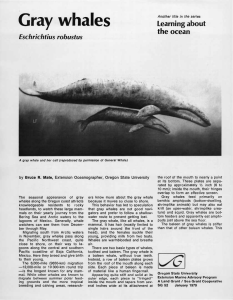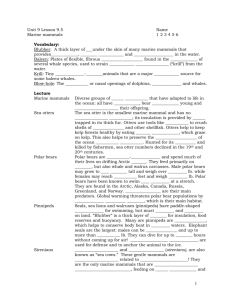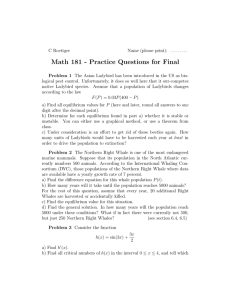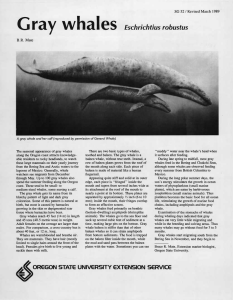Gray whales Eschrichtius robustus SG 52 / Revised January 1984
advertisement
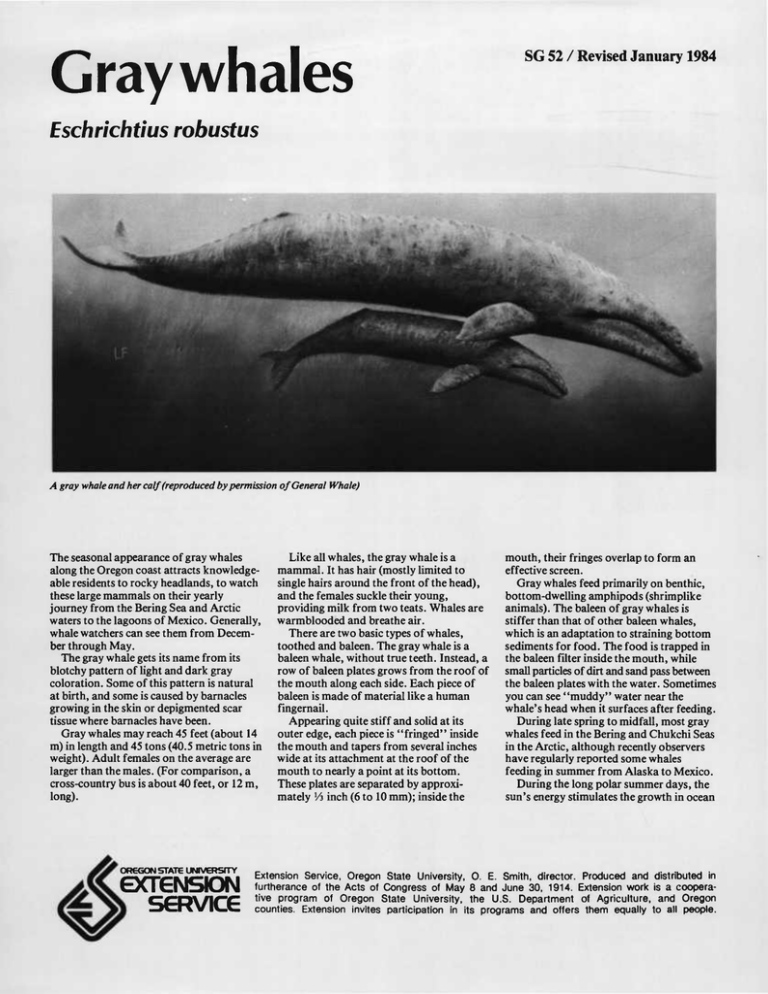
Gray whales SG 52 / Revised January 1984 Eschrichtius robustus A gray whale and her calf (reproduced by permission of General Whale) The seasonal appearance of gray whales along the Oregon coast attracts knowledgeable residents to rocky headlands, to watch these large mammals on their yearly journey from the Bering Sea and Arctic waters to the lagoons of Mexico. Generally, whale watchers can see them from December through May. The gray whale gets its name from its blotchy pattern of light and dark gray coloration. Some of this pattern is natural at birth, and some is caused by barnacles growing in the skin or depigmented scar tissue where barnacles have been. Gray whales may reach 45 feet (about 14 m) in length and 45 tons (40.5 metric tons in weight). Adult females on the average are larger than the males. (For comparison, a cross-country bus is about 40 feet, or 12 m, long). —v-p—_ l_lf~|t I CSV I vlN^IUlM Like all whales, the gray whale is a mammal. It has hair (mostly limited to single hairs around the front of the head), and the females suckle their young, providing milk from two teats. Whales are warmblooded and breathe air. There are two basic types of whales, toothed and baleen. The gray whale is a baleen whale, without true teeth. Instead, a row of baleen plates grows from the roof of the mouth along each side. Each piece of baleen is made of material like a human fingernail. Appearing quite stiff and solid at its outer edge, each piece is "fringed" inside the mouth and tapers from several inches wide at its attachment at the roof of the mouth to nearly a point at its bottom. These plates are separated by approximately Vi inch (6 to 10 mm); inside the mouth, their fringes overlap to form an effective screen. Gray whales feed primarily on benthic, bottom-dwelling amphipods (shrimplike animals). The baleen of gray whales is stiffer than that of other baleen whales, which is an adaptation to straining bottom sediments for food. The food is trapped in the baleen filter inside the mouth, while small particles of dirt and sand pass between the baleen plates with the water. Sometimes you can see "muddy" water near the whale's head when it surfaces after feeding. During late spring to midfall, most gray whales feed in the Bering and Chukchi Seas in the Arctic, although recently observers have regularly reported some whales feeding in summer from Alaska to Mexico. During the long polar summer days, the sun's energy stimulates the growth in ocean Extension Service, Oregon State University, O. E. Smith, director. Produced and distributed in furtherance of the Acts of Congress of May 8 and June 30, 1914. Extension work is a cooperative program of Oregon State University, the U.S. Department of Agriculture, and Oregon counties. Extension invites participation in its programs and offers them equally to all people. Profiles of the gray whale surfacing and blowing (left), beginning the dive, and diving (reproduced by permission from Gordon C. Pike, Guide to the Whales, Porpoises and Dolphins of the North-East Pacific and Arctic Waters of Canada and Alaska). Above: Baleen grows from the edges of the upperjaw. It is very similar in composition to human fingernails. The smooth outer edges look a bit like a comb. Left: A single baleen plate. The smooth outer edge (atyour left) is all you can see in the picture above. However, the fringed inner edge (at your right) overlaps the fringes ofplates on either side, to form an effective mesh for trappingfood. waters of phytoplankton (small marine plants), which in turn are eaten by zooplankton (small marine animals). Thus these plankton become the basic food of all ocean animal life, including the gray whale. Examination of the stomachs of whales during whaling days indicated that gray whales eat very little—if at all—while migrating and while in the breeding and calving areas. Thus the females bearing young may go without food for as long as 5 months. Starting their migration south from Arctic waters in November, gray whales begin to pass along the Pacific Northwest coast in early December. They move quite close to shore, on their way to lagoons along the central and southern Pacific coastline of Baja California, Mexico. There they breed and give birth to their young. The 6,000-mile (9650-km) migration— 12,000-mile or 19,300-km round trip—is the longest known for any mammal. While other whales are known to migrate between summer polar feeding grounds and the more temperate breeding and calving areas, researchers know more about the gray whale because it moves so close to shore. This behavior has led to speculation that gray whales navigate by staying in shallow water. The southward migration along the Oregon coast lasts until early February, with most of the animals moving by in late December and early January. Pregnant females lead the migration, followed by mature adults of both sexes and then immature animals. Whales travel at about 5 miles an hour (8 km/h) southbound and about half that speed northbound. The northward migration is much more spread out. The immature animals (some of which may not have gone all the way to Mexico), adult males, and females without calves are the first to head north, passing Oregon in March and April. Later, females with calves move north at a somewhat slower rate; usually, most pass the Oregon and Washington coasts during May. Females not giving birth to a calf may mate one or more times during the calving season or during the northward migration. Frequently, more than one male will attempt to mate with a female at the same time, and "courting triads" are commonly seen rolling on the surface. Males may breed with more than one female. There seem to be no long-term bonds between males and females, or any bonds between males and newborn animals. Whales begin to arrive in their traditional wintering lagoons in mid-December, and the birth of calves starts soon after. Most baleen whales give birth in temperate or subtropical oceans, presumably to reduce the heat loss of their young. Females become sexually mature at about 8 years of age and give birth to a single calf, usually every other year. Occasionally females give birth in consecutive years or may have a 3- or 4-year interval between calves. The 15-foot (4.5-m) calf is born tail first and weighs over 1 ton (.9 metric ton). Births take place offshore as well as in lagoons, although lagoons may be favored because they have calmer water. Calf breathing is awkward at birth. Calves take shorter, shallower dives than adults, breathing twice as frequently as their mothers for the first several weeks. Females nurse their young with rich milk that is nearly half fat and is squirted from two teats located on the underside of the mother. Calves are at least 1 month old before they start the northward migration. Gray whales were heavily exploited in the mid-1800's by whalers operating along the migration route and in the breeding grounds. Shore stations to process them were set up in San Diego around 1855, when navigation inside San Diego Bay was judged hazardous because of the abundance of breeding whales (according to one writer of that period). By 1873, gray whales had been so reduced in number that these shore stations closed. Operations continued within the lagoons and the gray whale population was further depleted. Gray whales were first protected by Mexican law, and subsequently by the International Whaling Commission in 1946. The species has recovered to what is now thought to be its preexploitation number—approximately 15,000. A quota of 176 whales per year is harvested by the Soviet Union. OSU Extension's Marine Advisory Program is supported in part by the Sea Grant Program, National Oceanic and Atmospheric Administration, U.S. Department of Commerce. The Marine Advisory Program provides education, training, and technical assistance to people with ocean-related needs and interests. Major efforts are concentrated in the areas of fisheries and wildlife, marine engineering, food science and technology, economics, business, resource management, education, and recreation. This publication was prepared by Bruce R. Mate, Extension marine biologist, Oregon State University.



